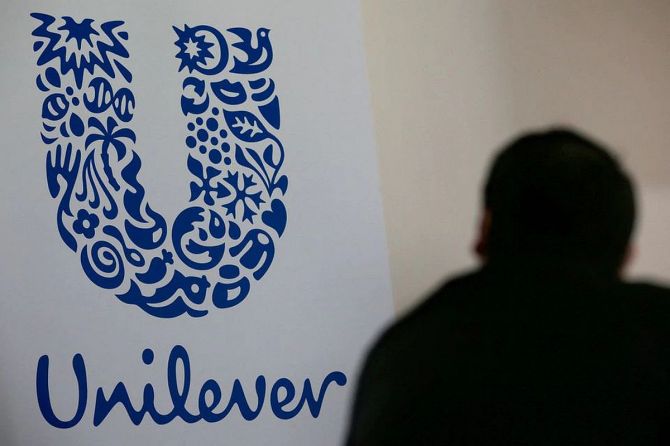Hindustan Unilever Ltd’s (HUL’s) second quarter 2025-26 (Q2FY26) consolidated revenue rose 2 per cent to Rs 16,250 crore, with low or flat volume growth. Demand remained stable but goods and services tax (GST) transition and prolonged monsoon hurt offtake.

Photograph: Philippe Wojazer/Reuters
Management expects the second half of the current financial year to be better than H1FY26.
Net sales grew 2.1 per cent year-on-year (Y-o-Y) to Rs 16,060 crore while underlying volume growth (UVG) was flat Y-o-Y.
Home care revenue declined 1 per cent YoY (UVG up mid-single digit), beauty and wellbeing rose 9.1 per cent Y-o-Y (UVG flat), personal care was flat Y-o-Y (UVG high-single digit decline), and food & refreshment grew 2 per cent Y-o-Y (UVG up low-single digit).
Gross margins contracted 20 basis points (bps) Y-o-Y to 51.4 per cent.
Operating profit margin contracted 80 bps Y-o-Y to 23 per cent.
The operating profit declined 1 per cent Y-o-Y to Rs 3,740 crore, profit before tax declined 5 per cent Y-o-Y to Rs 3,400 crore, net profit (before extraordinary items) declined 4 per cent Y-o-Y to Rs 2,500 crore, and reported net profit rose 4.1 per cent Y-o-Y to Rs 2,690 crore.
An exceptional item of Rs 184 crore due to resolution of prior-year tax matters between the UK and Indian tax authorities had a one-off positive impact.
Among segments, home care delivered mid-single-digit volume growth while revenue declined 1 per cent Y-o-Y, due to price cuts in Q2FY26.
Segment margins contracted 30 bps Y-o-Y to 19.1 per cent. The beauty & wellbeing segment saw revenue increasing 9 per cent, driven by skin care and health & wellbeing.
Skin care and colour cosmetics grew in high single digits.
Margins contracted 440 bps to 28.4 per cent due to higher investments in brands. Personal care had flat Y-o-Y revenue growth, impacted by the GST transition.
Volumes declined to high single digits, supported by calibrated price hikes due to commodity inflation.
Oral care saw marginal decline. Segment margins expanded 340 bps Y-o-Y to 20.3 per cent, with segment profit up by 21 per cent Y-o-Y.
Food & refreshment (F&R) revenue grew 2 per cent. Beverages grew in double digits.
Lifestyle nutrition showed sustained underlying volume growth.
However, sales were impacted by pricing actions taken in previous quarters.
Packaged foods had a subdued performance. Segment profit declined 9 per cent Y-o-Y.
In H1FY26, net sales, operating profit, and adjusted net profit grew 4 per cent, fell 1 per cent, and grew 5 per cent, respectively.
E-commerce now contributes 8 per cent to total sales (12 per cent in urban markets) while general trade forms 70 per cent and modern trade about 20 per cent, with all channels recording growth.
HUL remains in the investment phase for e-commerce, with a “design-for-channel” strategy, to develop packs suited to e-commerce and quick commerce platforms.
Over 50 per cent of HUL’s marketing investments are now allocated to digital media, supported by data-driven insights from its in-house analytics platform Sangam.
Under new leadership, HUL remains focused on volume-led growth, even at the expense of margins.
About 40 per cent of the portfolio has transitioned to the 5 per cent GST bracket, and HUL has undertaken pricing and grammage revisions across more than 1,200 stock keeping units.
The firm extended support to trade partners during the transition to ensure price pass-through.
Temporary disruptions occurred at distributor and retailer levels due to GST rate revision, but normal trading conditions will resume from November.
Management expects the impact of GST cuts, easing inflation, and an accommodative monetary policy will drive a recovery in consumption, particularly in rural markets.
The firm plans to focus aggressively on volume acceleration and premiumisation across categories.
Supportive macroeconomic factors may boost consumption sentiment.
As a market leader in many categories, HUL is well-positioned.
The company has loaded its winter portfolio into trade and expects a good winter.
The near-term operating profit margin guidance is in the 22-23 per cent range, with 50-60 bps expansion expected following the demerger of the low-margin ice cream business.
HUL thinks FY27 will serve as a more accurate benchmark for assessing the impact of its ongoing initiatives and structural changes. Analyst consensus on the stock remains positive.
Disclaimer: This article is meant for information purposes only. This article and information do not constitute a distribution, an endorsement, an investment advice, an offer to buy or sell or the solicitation of an offer to buy or sell any securities/schemes or any other financial products/investment products mentioned in this article to influence the opinion or behaviour of the investors/recipients.
Any use of the information/any investment and investment related decisions of the investors/recipients are at their sole discretion and risk. Any advice herein is made on a general basis and does not take into account the specific investment objectives of the specific person or group of persons. Opinions expressed herein are subject to change without notice.




